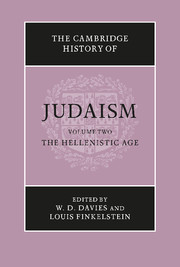Book contents
- Frontmatter
- 1 The archeology of Hellenistic Palestine
- 2 The political and social History of Palestine from Alexander to Antiochus III (333–187 B.C.E.)
- 3 Hebrew, Aramaic and Greek in the Hellenistic age
- 4 The Diaspora in the Hellenistic age
- 5 The interpenetration of Judaism and Hellenism in the pre-Maccabean period
- 6 The men of the Great Synagogue (circa 400–170 .b.c.e.)
- 7 Pharisaic leadership after the Great Synagogue (170 B.C.E.–135 C.E.)
- 8 Antiochus IV
- 9 The Hasmonean revolt and the Hasmonean dynasty
- 10 Jewish literature in Hebrew and Aramaic in the Greek era
- 11 Jewish–Greek literature of the Greek period
- 12 The Apocrypha and Pseudepigrapha of the Hellenistic period
- 13 The book of Daniel
- 14 The matrix of apocalyptic
- 15 The Septuagint and its Hebrew text
- 16 The Targumim
- 17 The Samaritans
- 18 The growth of anti-Judaism or the Greek attitude towards the Jews
- Bibliographies
- Chronological table
- Index
- References
5 - The interpenetration of Judaism and Hellenism in the pre-Maccabean period
Published online by Cambridge University Press: 28 March 2008
- Frontmatter
- 1 The archeology of Hellenistic Palestine
- 2 The political and social History of Palestine from Alexander to Antiochus III (333–187 B.C.E.)
- 3 Hebrew, Aramaic and Greek in the Hellenistic age
- 4 The Diaspora in the Hellenistic age
- 5 The interpenetration of Judaism and Hellenism in the pre-Maccabean period
- 6 The men of the Great Synagogue (circa 400–170 .b.c.e.)
- 7 Pharisaic leadership after the Great Synagogue (170 B.C.E.–135 C.E.)
- 8 Antiochus IV
- 9 The Hasmonean revolt and the Hasmonean dynasty
- 10 Jewish literature in Hebrew and Aramaic in the Greek era
- 11 Jewish–Greek literature of the Greek period
- 12 The Apocrypha and Pseudepigrapha of the Hellenistic period
- 13 The book of Daniel
- 14 The matrix of apocalyptic
- 15 The Septuagint and its Hebrew text
- 16 The Targumim
- 17 The Samaritans
- 18 The growth of anti-Judaism or the Greek attitude towards the Jews
- Bibliographies
- Chronological table
- Index
- References
Summary
GREEKS, BARBARIANS AND JEWS: THE PROBLEM OF HELLENIZATION IN THE EARLY HELLENISTIC PERIOD
A description of the interpenetration of Judaism and Hellenism in the pre-Maccabean period, that is, in the 158 years between 333 and 175 b.c.e., presents us with a twofold difficulty. Firstly, from this period we have only fragmentary and sporadic reports about the Jews in Palestine and the Diaspora. Non-Jewish literary sources are almost completely silent, and, where they do provide information, they are minimally concerned with the absorption of Hellenistic culture by the Jews. Even epigraphic, papyrological and archeological evidence is in the main sparse and often difficult to assess. Furthermore, Jewish literature of this epoch can often be dated only hypothetically, and most often can be used only as indirect evidence of this penetration or of repulsion. It either (at least apparently) says nothing at all about relationship to its Hellenistic environment or, in the case of polemic or apologetic writings, it presents a biased view. Nearly all the Jewish literature available to us from this period is religiously and nationalistically biased. A complete picture cannot be derived from such sources, and we can at best only describe individual situations and developments as they are fortuitously presented to us in the sources.
Secondly, although we can grasp fairly clearly what ‘Judaism’ means, i.e. those belonging to the Jewish ethnos both in Palestine and the Diaspora, their religion, their way of life and their literature, the much used terms ‘Hellenism’ and ‘Hellenization’ are less clear and more subject to dispute.
- Type
- Chapter
- Information
- The Cambridge History of Judaism , pp. 167 - 228Publisher: Cambridge University PressPrint publication year: 1990
References
- 1
- Cited by

